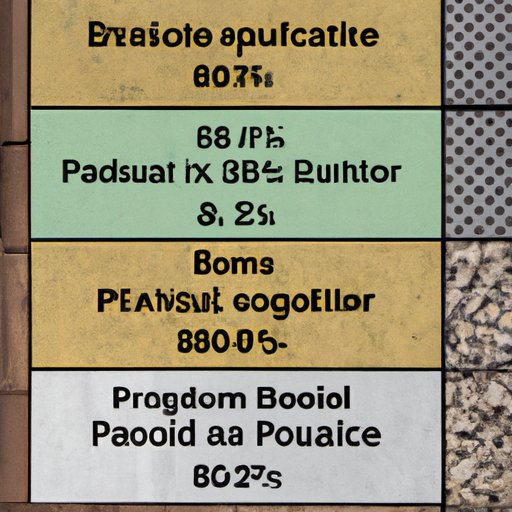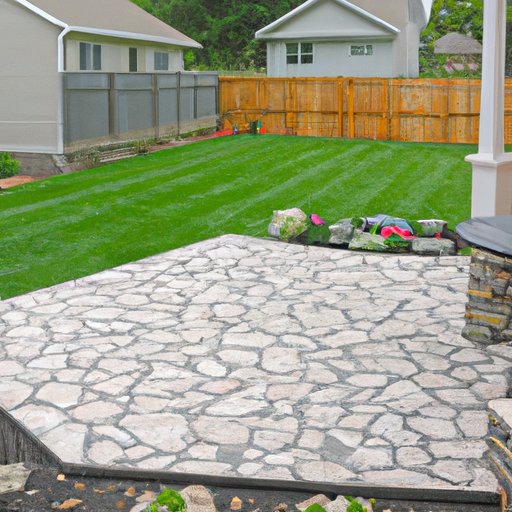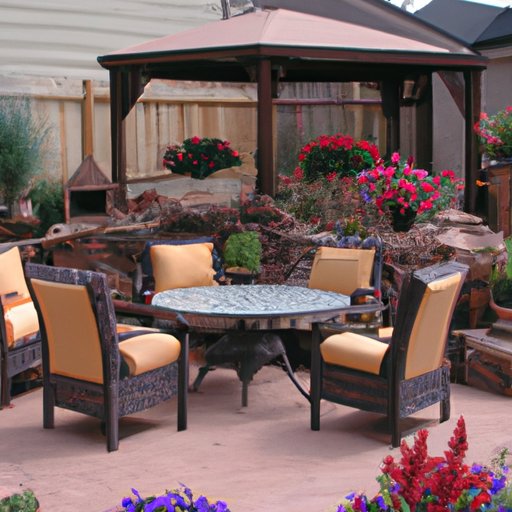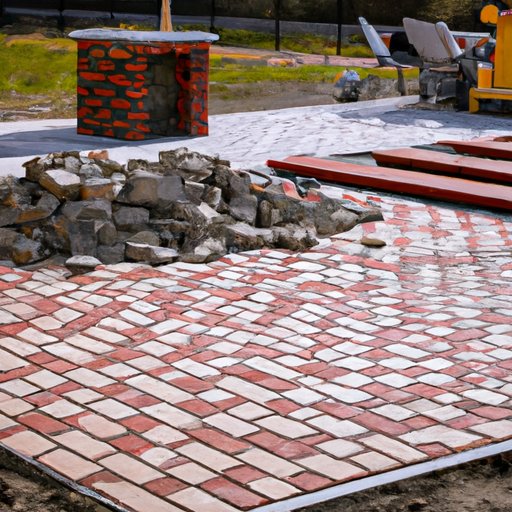Introduction
A patio is an outdoor living space that can provide a great place for entertaining family and friends or just relaxing outdoors. Patios come in all shapes and sizes, and there are a variety of materials to choose from when constructing one. Knowing how much a patio will cost is a key factor in deciding whether or not to install one.

Cost Comparison of Different Patio Materials
There are many options when it comes to choosing the material for your patio. Some of the most popular materials include concrete, wood, brick, stone, asphalt, and pavers. Each of these materials has its own pros and cons, as well as varying price points. Here’s a look at the average cost of each type of material:
- Concrete: $3-$15 per square foot
- Wood: $10-$20 per square foot
- Brick: $15-$30 per square foot
- Stone: $20-$50 per square foot
- Asphalt: $3-$7 per square foot
- Pavers: $10-$30 per square foot
It’s important to note that the cost of the material is just one factor when determining the total cost of a patio. The cost of installation is also an important consideration.

The Average Cost of a Professionally Installed Patio
When having a patio professionally installed, there are several factors that can affect the cost. These include the size of the patio, the quality of the materials used, and the complexity of the design. On average, a professionally installed patio will cost between $1,500 and $5,000.
In addition to the cost of the materials, professional installation usually includes labor costs, which can vary depending on the complexity of the project. Professional installation can also include additional services such as grading, excavation, and drainage, which can add to the overall cost of the project.
DIY vs Professional Installation: What is the Cost Difference?
If you’re considering doing some or all of the work yourself, you may be wondering what the cost difference is between DIY and professional installation. The cost savings of DIY installation can be significant, but it’s important to consider the time and effort involved in a DIY project. If you’re not experienced in construction, it’s recommended that you hire a professional contractor.
On average, DIY installation of a patio will cost between $500 and $2,000. This includes the cost of materials, but does not include the cost of labor. It’s important to note that DIY installation may require specialized tools and equipment, which can add to the cost.

Factors That Affect Patio Prices
In addition to the type of material and whether you choose to do the work yourself or hire a professional, there are several other factors that can affect the cost of a patio. These include location, size, style, and quality of materials.
Location can have a big impact on the cost of a patio. If you live in an area with high labor costs, you can expect to pay more for installation. The size of the patio is also a factor, as larger patios will require more materials and labor.
The style of the patio and the quality of materials used can also affect the cost. For example, if you choose to use higher-end materials like natural stone, you can expect to pay more than if you use basic materials like concrete. Similarly, more intricate designs may require more materials and labor, resulting in higher costs.
Pros and Cons of Popular Patio Materials
Concrete is a popular choice for patios due to its durability and low cost. It is also easy to install, making it a good option for DIYers. However, concrete can be prone to cracking and staining, and it is not as aesthetically pleasing as other materials.
Wood is another popular option for patios. It is relatively inexpensive and easy to work with, and it has a classic, natural look. However, wood is susceptible to rot, so it requires regular maintenance. In addition, wood can be more expensive than other materials.
Brick is a durable and attractive option for patios. It is available in a variety of colors and styles, making it easy to customize your patio. However, brick can be expensive and requires regular maintenance to prevent cracking.
Stone is a luxurious and long-lasting material for patios. It is available in a variety of colors and styles, and it can be used to create intricate designs. However, stone can be expensive and difficult to install.
Asphalt is a budget-friendly option for patios. It is easy to install and requires minimal maintenance. However, asphalt can be prone to cracking and fading over time.
Pavers are a popular choice for patios due to their versatility. They are available in a variety of colors and styles, and they can be easily installed. However, pavers can be more expensive than other materials, and they require regular maintenance.
Cost-Saving Tips for Your Patio Project
If you’re looking to save money on your patio project, there are several steps you can take. First, shop around for materials. Compare prices at local stores and online retailers to get the best deal. Second, compare prices of local contractors to get an idea of what the installation cost will be.
Finally, consider doing some of the work yourself. Even if you don’t have experience in construction, you can still save money by taking on some of the simpler tasks associated with installing a patio. This can include tasks such as clearing the area, laying the foundation, or laying the pavers.
Conclusion
Patios can be a great addition to any home, but it’s important to know how much they cost before starting a project. The cost of a patio will depend on the type of material used, the size of the patio, and the complexity of the design. On average, professionally installed patios cost between $1,500 and $5,000, while DIY patios cost between $500 and $2,000. There are a variety of cost-saving tips you can use to reduce the cost of your patio project, such as shopping around for materials and doing some of the work yourself.
(Note: Is this article not meeting your expectations? Do you have knowledge or insights to share? Unlock new opportunities and expand your reach by joining our authors team. Click Registration to join us and share your expertise with our readers.)
